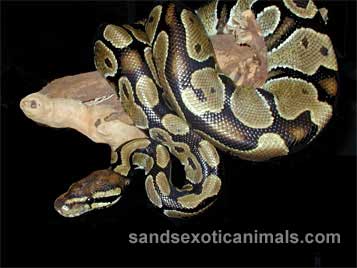
Origin:
The grasslands west of the Nile River in west Africa.Description:
Ball pythons are the smallest of the African pythons. They are stocky, boldly patterned animals. The pattern of blotches on the brown ground color varies considerably, but usually includes some type of yellow. The ball python size ranges from 3 to 5 feet for adults. They get their name from the habit of coiling into a tight ball when they feel threatened. Ball pythons are also called royal pythons.Feeding:
Wild ball pythons are mainly rodent eaters that feed on native African rodents including various rats and gerbils. In captivity they do not readily feed on mice because they do not occur in their native habitat. Therefore, they have to be converted to new prey before they begin feeding in captivity. There have been numerous reports of ball pythons fasting for up to a year before they begin feeding. Water should be placed in a bowl deep enough for the ball python to submerge in to aid in shedding.Housing:
Ball pythons can be kept in all glass enclosures with screen tops or custom built wood enclosures. Until the snake is acclimated, the best ground medium is newspaper. Once the snake is acclimated, media such as bark or aspen bedding can be used. A shelter is a good idea in the successful maintenance of ball pythons. A basking branch also makes a great addition and aids in the shedding process.Lighting:
Ball pythons are primarily nocturnal and no special light is required for maintenance. Full spectrum bulbs or low wattage bulbs can be used.Temperature:
Ball pythons require high temperatures to fare well in captivity. In the cage the air temperature during the day should be 80 to 85 degrees Fahrenheit. At night the temperature can safely drop to 75 to 80 degrees Fahrenheit as long as a heat source (under-tank heater or heat rock) remains for basking. A thermometer is recommended to monitor the temperature.Handling:
The ball python's docility (coiling up in a ball or moving between the handler's hands without biting) can be a sign of stress. Also, if your ball python is active, it is probably exhibiting flight behavior trying to escape what it feels to be a threatening situation. Keep in mind that if your ball python is not feeding it could be due to stress.
Compliments of:
S & S Exotic Animals, Inc., 1711 Connorvale, Houston, TX 77039 (281) 590-0426
http://www.sandsexoticanimals.com
